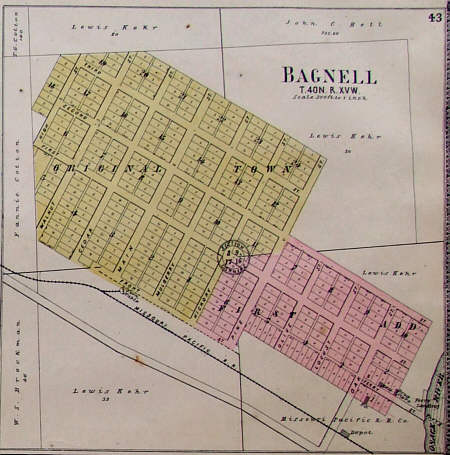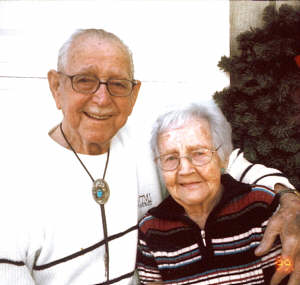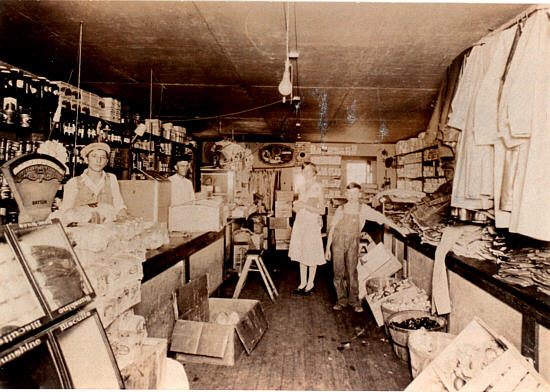
BAGNELL
The Eldon Advertiser and Miller County Autogram-Sentinel
1976 Bicentennial Salute
 |
Before Bagnell became a reality there was a church known as Old Gilgal at the point of a hill at the mouth of the Little Gravois Creek on the Osage River. Here the first annual session of the County Association of Baptist Churches was held in September, 1845.
Also preceding Bagnell was the village of Adelaide, also on the Osage, which had a population reported at 75 in 1880. Shortly afterward, though, the town moved across the creek. The Jefferson City, Lebanon and Southwest Railway never reached Lebanon and to the Southwest, but it terminated at what later became the Town of Bagnell. It was in 1882 that the town of Bagnell began growing up around this terminus of the Missouri Pacific branch line from Jefferson City.
In January, 1883, the original town of Bagnell was surveyed by William Bagnell along the railway, and was given his name. Some sources say Bagnell was a railroad man; others recall he started a store across the Little Gravois Creek from present day Bagnell and later agreed to grade the switch-bed at the end of the railroad line if the place would be named for him and another source lists him as being in the tie industry along the Osage River.
The original Town of Bagnell was the area now known as "Penny Town," a name that developed from the hotel, the Pennington House, operated by Sam Pennington, This building, no longer there, was in more recent year the Tom Quinn home.
It was July 17, 1885 when Bagnell got its First Addition, closer to the river, also surveyed by William Bagnell, and to become the center of the business district as remembered during the boom days of Bagnell Dam construction. Oak Street, on which Camp Bagnell's office now fronts, was a part of the new addition which was laid out with four other streets on the hill behind it-Locust, Olive, Pine and Hickory-before joining the Original Town of Bagnell. Ferry Street, leading down to the river and the ferry, had two streets designated on the hill above it''First and Second Streets.
Houses never blossomed on all those streets laid out on paper, but is recalled that once there was a Methodist Church atop the hill and a school, too. By 1889, its population was listed as 100.

Bagnell, Railroad tie Capital of the World, circa 1903
Another addition-the Bagnell Realty Company's Addition, Dec. 28, 1913, was laid out by Homer P. Vance and W.M. Tompkins between the railroad right of way and Little Gravois Creek and between Oak Street and the river, and two of the streets bear their names. The town was incorporated in 1926.
Bagnell, a river port, a tie center, a railroad terminus, and with its ferry, the only link across the Osage from the toll bridge at Linn Creek to another at Tuscumbia, had long been a bustling community. But its hopes brightened even more in 1926 when the State Public Service Commission on Jan. 13 granted Missouri Hydro-Electric a certificate of public convenience and necessity to build and operate a hydro-electric power plant on the Osage River near Bagnell.
Financial difficulties interrupted this project, but the bubble didn't burst for on July 4, 1929, the Missouri PSC granted permission to Union Electric Light & Power Co., to buy the Bagnell power project from Missouri Hydro-Electric, and construction started Aug. 6, 1929.
By 1930 Bagnell's population had grown to 449 with residential areas and construction camps spread out around it. Franklin Township in which it is located, climbed to a population of 3,124 in 1930.
In the next decade, with construction of the dam completed, the population began to dwindle. Highway 54 now went across Bagnell Dam instead of using the ferry. Two disastrous fires struck in successive years. On April 30, 1931, six business houses and one residence in Bagnell were destroyed; on Feb. 9, 1932, another blaze took five buildings.
In 1933 the high school moved to the new School of the Osage off Highway 54 near Bagnell Dam, and in 1939 the grade school closed. In 1940, Bagnell's population was down to 188 and Franklin Township's had dropped to 1,555.
And then came the flood of 1943 in the wake of an 11-inch rain. After the flood the depot and Bagnell Baptist Church were moved to new locations on Highway 54 near what was then the Johnnie Mead Filling station. In early 1954 the railroad line was discontinued from Eldon to this relocated Bagnell depot.
Bagnell didn't die, though. Its 1950 population was listed as 74 and in 1970 at 60.
Ray Behrens remembers Old Bagnell
Ray originally was from Jefferson City but happened to meet Col James Harrison (who was from Miller County whose father, also named James, had a farm at Tuscumbia) while working for the recruitment center in Jefferson City. James was chief clerk of the state park at Kaiser but wanted to leave that employment so he arranged for Ray to take his position. For a while, James would meet Ray in Eldon and they would travel together to Kaiser. For recreation they would go to the White House on the Bagnell Dam strip and there is where Ray and Brooksy met. She was the daughter of Curb Bowlin who ran the ferry for a number of years in Bagnell. Brooksy's mother's maiden name was Bunch and she was from Linn Creek. Curb's first wife had passed away and a second marriage failed before he met Miss Bunch. Brooksy weighed only three pounds at birth but did well spending most of her life in the village until 1971 when she and Ray left to live nearby in Eldon. In addition to many interesting endeavors one memory stands out when Brooksy worked for the Union Electric Land and Development Co. when she had the opportunity to serve as guide for Charles Lindbergh on his first visit to Lake of the Ozarks. Brooksy was a member of the first graduating class of School of the Osage in 1934.
Ray didn't work long as clerk of the state park but he does remember Earl McDaniel, owner of a farm in the middle of the sixteen thousand acres which the state had acquired for the park. Earl, according to Ray, gave the state "fits" because he had little fencing around his property and the cattle tended to migrate onto state owned property.
After leaving the clerk's position for the state park Ray bought Madison Bear's grocery store in Bagnell but because many of the residents had left the town he decided to raise turkeys in the building in place of running a grocery. Unfortunately, the building burned and the venture failed. Ray has fond memories of Madison and those who worked for him at the grocery store including Basil and Jesse Payne as well as Madison's nephew, Frank Martin. Especially one memory remains of Madison's store: the night of the day he married Brooksy, the couple were in the home nearby in Pennytown provided for them by Brooksy's mother when an awful clatter outside the house occurred accompanied by the sounds of guns firing. Of course, it was a chivari. So Ray ran down to Madison's store to buy treats and food for the celebrators. The store was located next to where the current restaurant now is placed. He felt fortunate the store was open at that time of night; however, during the boom years the store was ordinarily open for long hours, but in those later years business was reduced because of decreasing workers in the area who had helped build the dam.
John Bowlin, a cousin of Curb was a barber in Bagnell at the time and another cousin, Benjamin Bowlin was a doctor in town. Brooksy's mother had a restaurant across the street from Madison Bear's store (which was his second as the first one had burned). It was her second restaurant as the first had burned along with Madison's first store. Curb eventually sold the ferry to Bob Howser and Harry Ray. For awhile, Madison was said to have owned the ferry but this may have been some kind of arrangement to receive payment on a debt rather than outright ownership since Madison's name is not recorded in records at the courthouse as ever being an owner according to Dwight Weaver, author of several books about the Lake area.
 |
Ray and Brooksy Behrens |
Ray and Brooksy have always been involved in community activities. One of his first achievements was to help Bagnell retain its incorporated status with the state. The issue had to go all the way to the Supreme Court but in the end Ray and the town of Bagnell won the issue. Involvement with the School of the Osage was important too; Ray was the originator and chairman for ten years of the Lake Ozark Lions Pun-Ga-Har-Jo. Also, Ray and Brooksy were involved in establishing the 24 year on-going Drive-in-Worship Services at Osage Beach and later in the formation of the Hope Lutheran Chapel at Osage Beach. Ray and Brooksy have been active in the county Republican Party and have been national delegates.
Memories of Old Bagnell
By Susie (Bear) Pryor
My memories of Old Bagnell revolve around the general store my father, Madison Bear, owned in Bagnell from the late 1920's until about 1935. He kept his other store in Tuscumbia which my mother managed while he, my brother Arthur, my uncle Ernest Abbett (dad's brother-in-law) and my cousin, Frank Martin (dad's nephew) ran the Bagnell store. Dad went to Bagnell to take advantage of the increased business opportunity due to the building of Bagnell Dam during those years. Bagnell, however, was already a thriving community because it was the railroad pick up point for all the railroad ties which farmers upstream hacked (or as the old timers called it, "whacked out") from the large oak trees on their farms and then floated downstream to Bagnell. The Missouri Pacific railroad company had placed a spur line from Eldon just for that purpose, and Bagnell became known as the "railroad tie capital of the world".

Frank Martin, Madison Bear, unidentified customer, David Bear
Another source of business was the presence of a ferry at Bagnell which transported people back and forth from the south side of the river for the purpose of selling their produce as well as buying supplies to take home. My sister-in-law, Lena (Brown) Bear lived south of the river and when she started school she rode the ferry across the river there at Bagnell which cost a nickel a day (but I think the ferry captain never did charge her for it). My Dad owned that ferry for a short while as a means of repayment of a debt by the ferry's current owner. The ferry seemed to change owners frequently in those days.
When construction of the dam began, my sister Marie and her husband Bob Stillwell (son of the Tuscumbia attorney, Walter Stillwell) came to live at Bagnell so Bob could work for Union Electric Company. Although he had gone to the University of Missouri and trained as an engineer, a shortage of common laborers required that he work as a painter on some of the rusting iron works which were lying around waiting to be incorporated into the dam structure. During that time they first lived a little way up on the hill behind Dad's store in a row of apartments, Bob then got promoted, allowing Marie to quit working for Dad, and she and Bob were able to move up to what Union Electric Company called the Three Room Camp . Union Electric had built two camps for their employees: the Three Room Camp and the Five Room Camp. I thought it was wonderful at the time. Their daughter, Carol, was born there and I often would ride up with Dad in the mornings to visit them and baby sit Carol.
Dad delivered groceries from his store at Bagnell all around the area. Everything was booming with people coming from far and near hunting jobs since the depression was going on elsewhere in the country. However, this brought in all kinds of people both good and bad. One night a man with a gun came into Dad's store and held up the cashier, who was my cousin Frank Martin, and emptied out the cash register. Needless to say Frank was scared to death. The next day my Dad went to a little room in the back to cut a hole in the wall that was large enough to stick a gun through if another robber should come in again. Dad always had a lot of money in the cash register which would come in throughout each day so the store was a tempting target to some of the more unscrupulous characters around Bagnell.
Behind the store Dad built a huge storage building where Frank Martin and Uncle Ernest Abbett, my Mom's brother, slept upstairs. One night the store building caught fire and people started yelling "Fire, Fire, Fire" whereupon Frank and Uncle Ernest came running down the stairs pulling their breeches up as they ran. Both the store was burning as well as the storage room. Since our family didn't live up at Bagnell but remained living in Tuscumbia, Dad drove home every night so he wasn't present when the fire started. However, sometime in the middle of the night our neighbor, Ila Brockman, who had the phone exchange at the Brockman Hotel in Tuscumbia, got the call to go wake all our family. So she came out her door yelling all the way to our house, big and loud as she could, "MADISON, MADISON, YOUR STORE'S ON FIRE!" Well, you can imagine the awful terror we went through the rest of the night. All the grown-ups went up there and the kids stayed home wondering what was going on. Well, the news wasn't good; Dad had lost everything he owned in that store, and in those days insurance wasn't common to have for about anything. Dad always suspected that the neighbor store's owner, who had insurance, may have set the fire. It was big news in Bagnell. However, Dad hurriedly built another building and stocked it with a little bit of everything essentially starting all over again. He even installed a Slot Machine. Maybe that wasn't such a good idea. One night a man came into the store drunk and cursing ever so loud in a very threatening manner heading toward the slot machine. Dad told him to get out but the man (who was very large) raised his fists ready to fight so Dad picked up a big iron stove poker lying close to the stove, raised it up ready to strike whereupon the man chickened out. I know the man's name but I'm not going to write it down because he was a local person and was very sorry for what he did afterward.
I tell you it was a rough crowd up there at Bagnell. The town's population had increased with the building of the dam mostly by men who either were single or had left their families back home. In their free time it seemed that all they did was drink and fight. Actually, fighting almost seemed to be more a pastime than a result of arguments. In fact, fights would be arranged and gambling took place among the crowd of spectators who found this to be a very entertaining way to spend their time and money. The fighting took place just outside Dad's store. My brother, Arthur, who worked there everyday became very intrigued by the fist fighting. After awhile, boxing gloves were introduced because the men didn't have the money to keep going to the doctor to get fixed up from the injuries of bare knuckle fighting. So Arthur thought he would try to learn how to "box". Who taught him? Well, it was our grandfather David C. Bear. The fact is, fist fighting was a common pastime for his generation as well, and he was, apparently, one of the better ones in his day. He was so good, that even at eighty years of age, Arthur never could land a good punch on him; that is, except for the last day they boxed when a lucky fist broke grandpa's defense and cracked some of his ribs. He allowed after that day that Arthur was good enough and didn't need any more "lessons". Arthur became very good at boxing at Bagnell. Lloyd Slone said he was one of the best boxers around.
Well, business slowed in Bagnell as the mid thirties rolled around due to all the traffic taking the highway 54 route across the dam rather than using the ferry at Bagnell as well as the fact that all the laborers had gone home. Dad sold the store to Ray Behrens who raised some turkey poults in it. But lo and behold if that store didn't burn down too after which Ray never rebuilt it. Wasn't much going on anymore in Bagnell, I guess.
Love,
Mom